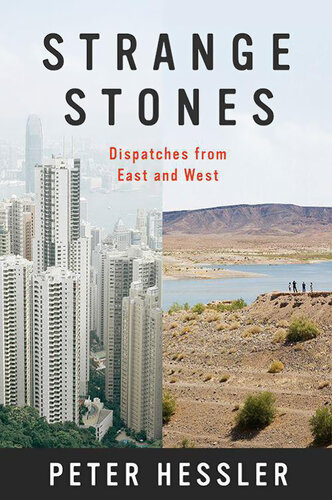
Strange Stones
Dispatches from East and West
کتاب های مرتبط
- اطلاعات
- نقد و بررسی
- دیدگاه کاربران
نقد و بررسی

March 11, 2013
In 18 elegant and thoughtful essays,
almost all previously published in the
New Yorker, prize-winning writer Hessler reflects on the foreign and the familiar,
offering profiles of people who are often “chameleonlike, while others dreamed of returning home,” as well as a few who were engaged in “creative bumbling.” Although many of the essays focus on China, where he lived for a decade and a half, they range over topics from rat restaurants and life in a Chinese boomtown to life in the uranium town of Uravan, Colo., to the experience of moving from China back the U.S. In a profile of pharmacist Don Colcord, from Nucla, Colo., Hessler provides a brief history of the this small town that grew up over a century ago and was named by idealists that hoped the community would become the “center of Socialistic government for the world.” Drawing upon the experience of one of his former students, Hessler provides a portrait of the Chinese boomtown Shenzen, illustrating how it became divided into two worlds, which were described by the residents as guannei and guanwai—”within the customs” and “outside the customs.” In one of the most hilarious and poignant essays, Hessler reflects on his move back to America after more than a decade away by recalling his victory in a half marathon in Las Vegas: “I had run alone down Frank Sinatra Boulevard, and I had appeared on Las Vegas television… Finally I was home, and I had a story to tell; in America that was all you’d ever need.”

February 15, 2013
A collection of personal essays and profiles that reveal the wonders and woes of the East. New Yorker staff writer Hessler (Country Driving: A Journey Through China from Farm to Factory, 2010, etc.) bridges the divide between East and West with riveting reportage. In the opening essay, "Wild Flavor," the author chronicles his visit to a restaurant in southern China, where the waitress casually asked, "Do you want a big rat or a small rat?"--a line that embodies the collection's interest in celebrating and questioning cultural differences. In the title essay, Hessler and an old Peace Corps buddy take a road trip across northern China, and the well-seasoned travelers find themselves duped at every turn--further evidence of the slow learning curve between cultures. Yet perhaps the theme running throughout most of these essays is the author's examination of the perils of living in a closed society, in which even the assistant manager of the aforementioned rat restaurant refused to give his name for the book (despite the fact that most of the village shares his name). In "Boomtown Girl," Hessler best elucidates this fear of oversharing with outsiders by introducing readers to Emily, a Chinese teacher-in-training who bucked all traditional gender roles and set out a future of her own making. While much of the book depicts a country consisting of walls, gates and fences--both literally and metaphorically--Emily's idealism reveals a new breed of Chinese woman, one whose intrepid spirit serves her well. A rich, vibrant collection that pries wide the door to the East, welcoming Western readers inside.
COPYRIGHT(2013) Kirkus Reviews, ALL RIGHTS RESERVED.

April 1, 2013
This work represents a collection of Hessler's (staff writer, The New Yorker; Country Driving: A Chinese Road Trip) writing from 2000 to 2012. In the title piece, he is curious when he sees sign after sign, "Strange Stones." Soon he learns that the Chinese refer to any rock that is shaped like another recognizable object as a "strange stone." In the essay "Dr. Don," Hessler introduces readers to the only medical man in tiny Nucla, Colorado. Don Colcord owns a local business, the Apothecary Shoppe, where he helps all who come to him, whether they have health insurance or not. Most moving is "When You Grow Up," in which readers meet three boys, ages 10, 12, and 14, who left their village in China to earn money for their families. After feeding them countless hotpots, Hessler asks what they want to be when they grow up. One wants to be a driver, another a security guard, and the third simply wants to go home. VERDICT Anyone who enjoys unique human interest stories will be greatly rewarded by this title.--Susan G. Baird, formerly with Oak Lawn P.L., IL
Copyright 2013 Library Journal, LLC Used with permission.

March 1, 2013
Hessler started out wanting to be a novelist, then drifted into journalism, taking with him a deep appreciation for storytelling and a love for the details of life. As Beijing correspondent for the New Yorker for seven years, he got a firsthand look at the travails of its modernization. In this collection of stories from China, Japan, Nepal, and the U.S., he offers an engaged outsider's perspective, as absorbed with meeting peopleincluding migrants and transplantsas with detailing geography and politics. The collection rambles, with no chronological order, as Hessler relays visits to competing restaurants in Guangdong Province famous for their rat dishes; the closing of the Three Gorges Dam; how the Olympics brought even more radical change to Beijing, a city already grappling with sudden modernity; hiking the Great Wall of China with an American expatriate; the peaceful transition of Chinese leadership; and visiting a Peace Corps enthusiast in Nepal pushing for a higher profile for the overseas service agency. Hessler also profiles basketball player Yao Ming, the pride of China.(Reprinted with permission of Booklist, copyright 2013, American Library Association.)

























دیدگاه کاربران